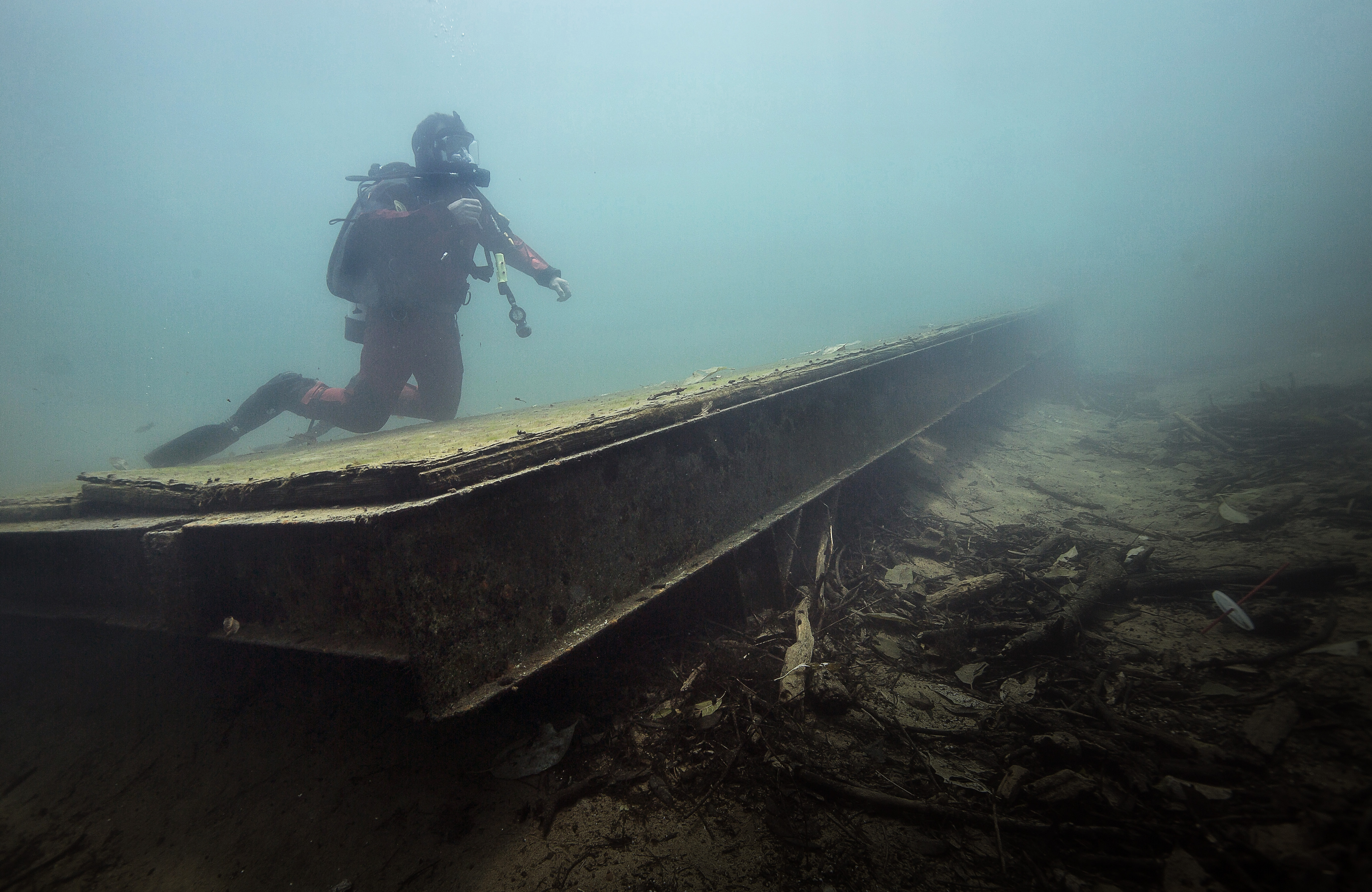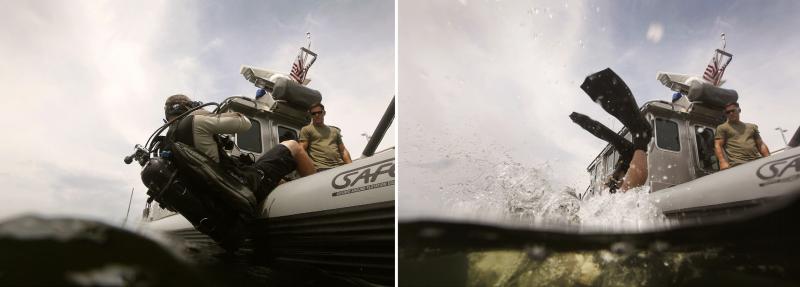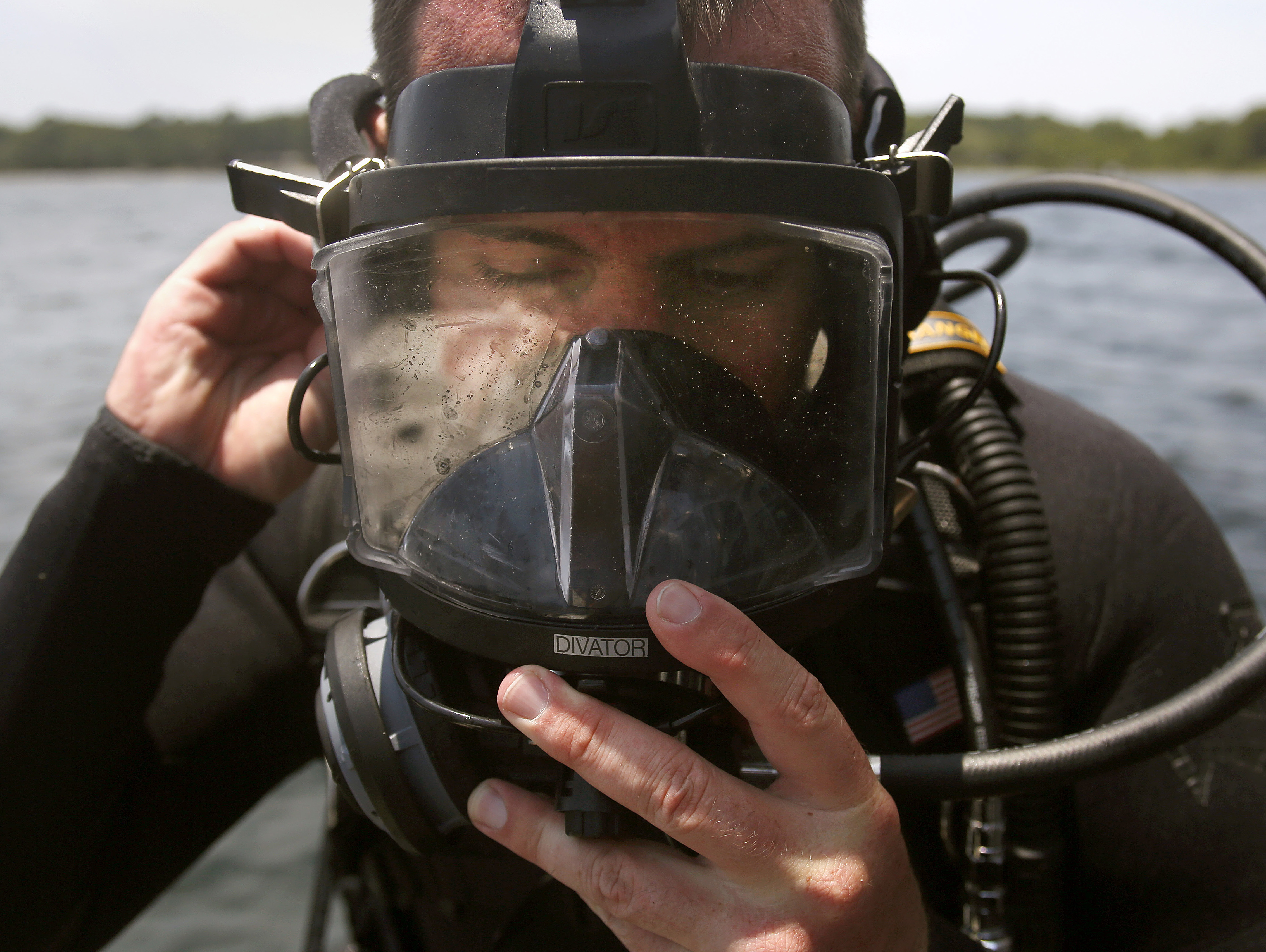
Investigating the Depths

While some fear the unknown, the more daring embrace it.
That best describes a specialized U.S. Customs and Border Protection unit, the Border Patrol’s BORSTAR underwater search-and-recovery dive team.
To grasp just how demanding the job is for these multiskilled diving experts, imagine blindly negotiating deep, cold, murky – and sometimes toxic – water, possibly dodging lethal marine life lurking about, or dangerous, hidden foreign objects.
A difficult but rewarding job
Dive teams conduct search-and-recovery operations and inspect under vessels for narcotics and explosives sometimes attached under the hulls of ships. Typical targets could be a corpse, weapon, vehicle or a container loaded with illegal narcotics, all of which are difficult to spot in water where visibility is many times measured in inches.
Diving is an advanced collateral duty requiring a lot of dedication because agents still perform their regular BORSTAR duties when they’re not in the water. To stay on the team, divers must be proficient in core specialties: tactical medicine, rope and swift-water rescue, land navigation, air operations and other Border Patrol requirements. They must also maintain annual certifications with dive equipment, maintenance, and search-and-recovery operations.
Just 60 divers assigned to CBP’s Southwest Border Patrol sectors and in the Blaine Sector make up the team.
"The type of diving that we do requires commitment, determination and a unique personality," said Marcus Adkinson, supervisory Border Patrol agent and BORSTAR dive team program manager who joined the team in 2012. "Divers have to perform their duties under a variety of hazardous environments and conditions.
"Being a team player is the most important requirement to be a BORSTAR diver," he said. "You have to rely on your teammates to complete all missions, and your life may depend on them. A diver may get entangled in rope or line and his teammates are there to help him. There is always a possibility of equipment failure, and we may have to share air to get to the surface."

A BORSTAR diver glides over a submerged log at roughly 40 feet as he enters the mouth of a subterranean spring at Morrison Springs near Panama City, Florida.
Making the cut
The standards to become a BORSTAR diver have evolved since the program started in 2002. Agents must have at least two years of service and successfully complete the BORSTAR selection and training course. Candidates are evaluated on the core specialties and their ability to work in a cohesive unit.
Once they make the cut, there’s considerable training- -emergency medicine, tactical medicine, emergency medical technician, paramedicine and austere medicine. Agents apply these skills in remote areas or in developing countries or during widespread disaster or mass casualty events.
Other training includes load planning, helicopter rope suspension, operating rescue watercraft and other boats. There’s also, cold-weather operations, personnel recovery, small-unit tactics, combat casualty care, and managing and planning operations.
In addition to certifications, divers must maintain and service equipment. "It’s considered life support equipment because our lives depend on it to work properly," Adkinson added.
While diving may sound like fun, the reality is quite different. "It’s a lot of hard work. It’s maintenance, intensive training and hazardous. Basically, it’s not a walk in the park. You have to be willing to work hard. Everything we do is done for a reason. Everything has a checklist. When someone’s 90 feet under water, there’s no room for error," he pointed out.

Tethered to a surface air supply umbilical, U.S. Border Patrol Agent Carl Newmayer of the BORSTAR dive team walks along the sea floor in the murky bay waters as he tests a HAZMAT dry suit in Panama City, Florida.
Equipped for the challenge
BORSTAR divers use two types of gear: Equipment that pumps air from the surface and scuba.
The extreme lightweight diving system, is a surface-supplied system and the only type CBP uses. An umbilical cord secured to the diver’s helmet supplies surface air and hard-wired communication. Monitors on the surface, oversee depth and air consumption. The equipment allows for longer dives. It’s engineered for rapid set up and deployment and used with the standard helmets, face masks and other diving gear.
Scuba, which stands for self-contained underwater breathing apparatus, is the other ensemble. This is the typical equipment most people envision—divers breathing air from a pressurized tank strapped to their back.
Scuba divers can reach depths up to 130 feet. They use full face masks and rubber-like wet suits that keep divers warm or dry suits for better protection in exceptionally cold or contaminated water. They use hand signals to communicate. Scuba allows for rapid deployment, freedom of movement and simpler preparation compared to the surface-supplied diving equipment.
However, there are cautions when using scuba gear and surface-supplied diving equipment. Dive-related illnesses such as decompression sickness and arterial gas embolism, a blockage caused by air bubbles in the blood, can occur. Many of these ailments are brought on by rapid ascents where the body doesn’t adjust to the changing pressure. U.S. Navy dive tables provide decompression times for specific depths.
Ceaseless training and testing
Recently, 12 of the dive team members met in Panama City Beach, Florida, for a course on using the advanced surface-supplied equipment. They also coordinated the largest joint diving exercise working with Air and Marine Operations (AMO), Florida Fish and Wildlife Conservation Commission, Bay County Sheriff’s Department, Panama City Beach Fire Department and Florida State University’s Evidence Recovery Program.

the BORSTAR dive team as Newmayer dons a hazmat dry suit near Panama City,
Florida.
The exercise involved vehicle and evidence recovery using sound navigation ranging, better know as sonar. Sonar uses transmitted and reflected sound waves to locate submerged objects.
Other recovery exercises took place at Morrison Springs and St. Andrews Marina near Panama City Beach. One scenario near a sunken vessel in the Gulf of Mexico concluded with a foreign vessel inspection and hull search with assistance from the U.S. Coast Guard.
Diver Carl Newmayer from the Tucson Sector, evaluated a hazmat helmet, designed for chemical, biological, nuclear or radiologically contaminated water. He said testing the helmet and a dry suit that enclosed the entire body was exciting.
"I always love diving with the helmets and to be the first one to do it [as a BORSTAR diver] is pretty cool," said Newmayer, who has helmet dived many times. "It’s a little bit quieter, you can think clearer."
"With this [dry suit and helmet], you could dive in raw sewage and have no exposure to it," he added.
The equipment "worked like a champ. It worked perfect," Newmayer said.
It was also the first open-water test, according to Rocky Heikkinen, the dive lab training director.
Not your typical work schedule
Days are long and grueling and can stretch into night. Typically, work begins early in the morning where the team loads gear onto a big truck, drives to the location and unloads it. There’s a lot of manual labor.
The next day, everything is loaded onto boats – usually, AMO’s Secure Around Flotation Equipped (SAFE) boat or the 28-foot Intrepid. Divers often work with AMO agents during training and exercises.
"Every person has their role," Newmayer said. That could be driving the truck, arranging for the boats or unloading the gear. Tasks hinge on the equipment required for the mission.
"Are we going to do the surface supply?" he offered. "If we go into that, then there’s a bunch of different people who have different jobs to set that up. If you go in scuba mode then you just individually grab the gear you need to set that up."
After the mission, there’s sometimes a long boat ride back to the dock where the work continues. Gear needs to be loaded back on a truck, returned and cleaned. "To keep us alive it’s very important that we clean our gear properly," said Newmayer.
Having the motivation to work under these conditions takes a special individual," he remarked. "Not everyone is cut out to do it. It can be a little disturbing to be down there and you can’t see anything," although Newmayer considers it a "tranquil experience."
"Me, I find it more peaceful," as he describes it. "I might feel something, maybe try to figure out what it is…you just close your eyes and go with it."
Adkinson, the dive team program manager, who began diving in 2004 as a hobby, said that it’s paramount divers stay focused on their task and potential hazards and not think about surrounding threats from marine life.

A BORSTAR diver conducts training exercises in Panama City, Florida.
"There is always a chance of encountering dangerous marine life," he said, "but if you are afraid of what’s going to hurt you in the water, then you are not able to do your job. All BORSTAR divers are EMTs and BORSTAR. Paramedic divers attend a specialized medical diving course with the U.S. Navy. There is always a dedicated dive medic and equipment on every operation or training to mitigate the risk of injury."
Phil Vanous, supervisory Border Patrol agent and dive team medic at the Laredo Sector Special Operations Detachment, also put the job in perspective.
"Sometimes when you mention scuba dive operations to other coworkers they think you’re down in clear water playing with fishes," he said, "when the truth of the matter is, this is probably the most dangerous job anyone in CBP will do."
Risking a bacterial infection from contaminated water, becoming entangled in debris, and limited visibility are just a few of the dangers divers face, Vanous pointed out. "If you have limited amount of air, if your tank runs empty, that’s it. That’s why we use the surface supply dive equipment for the more high-risk missions. That way if a diver does get entangled, we can keep providing him air."
It’s essential for divers to apply their skills, he said. "Some of the most important medical aspects of diving are making sure CBP divers are capable," said Vanous, who keeps tabs on a diver’s physical and mental health. "Some of the tasks are stressful. We are trained to control stress before it develops to fear and, even worse, panic."
Staying clear of those pitfalls is best expressed by the team’s motto: "Plan your dive, dive your plan."

Missions that pay off
The team logged roughly 20 missions from 2015 to 2016.
March 4, they recovered a vehicle loaded with narcotics from the Rio Grande River that smugglers attempted to float across near the Fort Brown Station, Rio Grande Valley Sector. Smugglers placed the vehicle on a floating trailer and towed it with a small boat. The trailer tipped, and the vehicle plunged into the river. The smugglers, however, retrieved the contraband.
The Rio Grande Valley special operations detachment dive team, working with other agencies and Border Patrol stations, recovered the vehicle after the dive team leader evaluated the conditions.
Submerged about 12 feet in zero visibility water, the vehicle needed to be lifted and floated down the river and removed by a wrecker. To do that, lift bags were attached to the vehicle, then filled with air, creating floats to lift the vehicle from the river.
May 12, another vehicle loaded with marijuana was recovered from the river by the Rio Grande Valley Sector special operations detachment, BORSTAR dive team. Divers used a special search pattern to find the vehicle and attached a chain to hoist it from the river. Five bundles of marijuana weighing 377 pounds were recovered.
In December 2015, BORSTAR divers from Special Operations Group headquarters, Yuma, Laredo and Tucson Sectors recovered an airplane that crashed into Lake Heron near Chama, New Mexico, four years earlier in April 2011. Twenty-three kilos of cocaine were recovered after washing up on the shore.
The recovery wasn’t attempted in 2011 because the mission was too complex and hazardous. Working with divers from the New Mexico State Police and
Albuquerque Police Department, the BORSTAR team recovered two large sections of the small, multi-engine, piston-driven aircraft, a Cessna 320F. Most of the wreckage was buried in layers of mud and silt, in the zero visibility 40-degree water. BORSTAR’s sonar and surface-supplied dive equipment made the task less hazardous.
"The New Mexico mission was definitely the most in-depth, extensive and dangerous mission that I’ve been part of," Newmayer said. "Every aspect of it was trying, in some way, for myself and every diver."
Tim Sullivan, chief patrol agent with the special operations group based in El Paso, noted the dive team is critical to national security.
"The threat to our ports and water borders is very real," he said. "The BORSTAR dive team provides CBP and DHS with another special operations capability to mitigate these threats."

